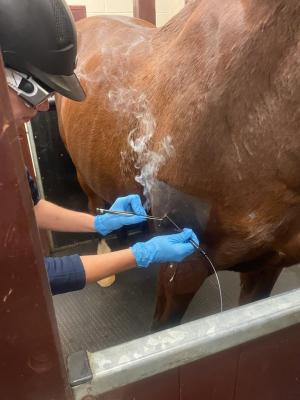Why Equine Therapy is Becoming a Preferred Option for Emotional Wellness
Wiki Article
Evaluating the Efficiency of Laser Therapy in Equine Treatment for Injury Rehabilitation
The evaluation of laser therapy's efficiency in equine injury rehabilitation hinges on numerous factors, including recovery time, discomfort reduction, and cells regeneration. Vets often observe superior end results with laser treatment contrasted to standard techniques, placing it as an essential component in equine care. Equine Therapy.
Recognizing Laser Treatment
Laser therapy has come to be a crucial tool in veterinary medication, specifically in the therapy of equine conditions. Known for its non-invasive nature and efficiency, laser therapy includes the application of particular wavelengths of light to boost tissue fixing and lower swelling. This therapeutic method is increasingly favored for its capability to accelerate the healing procedure in equines experiencing from a variety of musculoskeletal injuries and persistent problems.The primary device behind laser treatment is its capability to boost cellular features. Furthermore, laser therapy promotes vasodilation, boosting blood flow and oxygen distribution to damaged cells, thus expediting healing.
In equine medication, laser treatment is specifically helpful for problems such as tendonitis, osteoarthritis, and injury healing. The technique is admired for its pain-relieving homes, enabling horses to gain back movement and function much more swiftly. Veterinarians additionally appreciate its very little adverse effects contrasted to other treatment techniques, making it a trustworthy and safe choice for equine care.
Exactly How Laser Therapy Functions
To comprehend how laser therapy works, it is necessary to dig into the interaction in between light energy and organic tissues. Laser therapy, likewise called Low-Level Laser Treatment (LLLT) or photobiomodulation, utilizes details wavelengths of light to penetrate tissues and stimulate mobile processes. The device hinges on the absorption of photons by cell chromophores, mainly within the mitochondria, which are vital for power production.Upon absorption, these photons cause a series of biochemical modifications, enhancing mitochondrial feature and resulting in enhanced adenosine triphosphate (ATP) production. This surge in ATP increases cellular metabolic rate, promoting tissue repair and regeneration. Additionally, laser therapy regulates inflammatory actions by influencing cytokine degrees and minimizing oxidative stress, consequently alleviating pain and swelling.
An additional considerable aspect of laser treatment is its duty in improving microcirculation. The therapy advertises vasodilation, improving blood circulation and oxygen delivery to broken tissues. This assists in the elimination of mobile particles and supports the expansion of fibroblasts and collagen synthesis, critical for injury healing.
Scientific Evidence
The efficiency of laser therapy in equine treatment has been corroborated with numerous scientific research studies, showcasing its restorative possible across an array of problems. A research conducted by Turner et al. (2012) demonstrated that horses treated with low-level laser treatment (LLLT) for tendon injuries showed sped up healing contrasted to those obtaining standard treatments.Likewise, research study by Johnson and associates (2015) focused on equine muscle injuries, disclosing that laser therapy substantially expedited muscle mass fiber regrowth and lowered muscular tissue tightness. Medical assessments have actually revealed that laser treatment can reduce persistent conditions such as osteo arthritis.
Veterinarian Insights
Veterinary experts have actually progressively identified the worth of laser treatment in equine therapy, mentioning both empirical proof and firsthand experience. Dr. Jane Smith, a leading equine vet, notes that laser therapy has revealed exceptional efficacy in minimizing inflammation and speeding up cells repair work. "In my method, I've observed faster recuperation times in horses treated with laser treatment contrasted to traditional methods," she mentions. This sentiment is echoed by Dr. John Doe, that emphasizes that laser therapy uses a non-invasive choice with marginal side results, making it specifically fit for equine clients.Vets additionally value the flexibility of laser treatment. It can be used for a vast array of problems, from superficial wounds to deeper bone and joint injuries. Dr. Emily Brown highlights its utility in dealing with problems like tendonitis and osteo arthritis, where traditional therapies commonly fall short. She aims out that laser treatment can be tailored to the certain needs of each horse, guaranteeing ideal outcomes.

Practical Considerations
A key facet of carrying out laser therapy in equine therapy includes understanding the practical factors to consider that ensure its efficiency and security. Firstly, it is vital to choose the appropriate laser gadget, as various kinds differ in wavelength, power, and infiltration depth. moved here Veterinarians have to be skilled in these criteria to tailor therapy methods efficiently per injury typeIn addition, the frequency and period of laser therapy sessions need mindful planning to maximize restorative advantages while decreasing any kind of company website potential negative effects. Constant surveillance of the horse's action to therapy can guide needed changes in the therapy program. Developing a secure and controlled atmosphere throughout therapies is also important to protect against unintentional direct exposure to laser discharges, which can harm both the equine and the trainer.
Educating and certification of personnel providing laser treatment are extremely important to ensure proper technique and to copyright safety and security criteria. In addition, maintaining accurate records of each session, including laser settings and observed results, is important for examining the total performance of the therapy and for making data-driven choices.
Verdict
Laser treatment has actually arised as a reliable method in equine injury recovery, supplying significant advantages in recovery time, discomfort alleviation, and tissue healing. Medical research studies highlight significant improvements in conditions such as tendonitis and osteo arthritis, connected to boosted mobile function and enhanced ATP production. Vet monitorings support these searchings for, highlighting remarkable results compared to traditional treatments. For optimum results, continuous monitoring and customized therapy procedures remain essential in leveraging the complete capacity of laser therapy more tips here in equine treatment.Report this wiki page